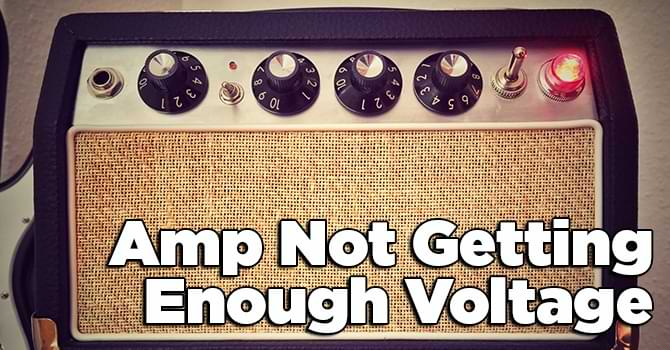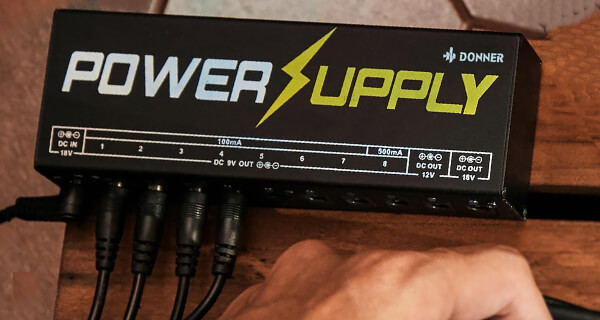Amp Not Getting Enough Voltage [Reason & Fix]
Are you an audio enthusiast or musician? If so, you’re well aware of the pivotal role voltage plays in powering your amplifier. Inadequate voltage can lead to subpar performance, distorted sound, and equipment damage. This comprehensive guide delves into the reasons behind this issue and offers practical solutions to ensure your amplifier receives the necessary voltage for top-tier sound quality. Let’s see the solution of amp not getting enough voltage.

# Table of Contents =>
a) Voltage Basics –
Before we tackle the intricacies, let’s grasp the fundamentals of voltage. Measured in volts (V), voltage represents the electric potential difference that propels electric current through a circuit. In amplifier contexts, voltage breathes life into the internal components responsible for enhancing audio signals.
b) Signs of Voltage Insufficiency –
Before delving into solutions, it’s vital to identify telltale signs of insufficient voltage affecting your amplifier:
Reduced Output Power: Your amplifier may yield significantly lower output power than expected.
Distorted Sound: Distortion, clipping, or diminished audio clarity may manifest.
Overheating: Inadequate voltage can lead to overheating, potentially harming internal components.
Protection Mode: Amplifiers often enter protection mode when voltage falls short, shutting down to prevent damage.
Dimming Lights: In extreme cases, you may witness your lights flickering in sync with the music, signaling severe voltage drops.
c) The Issues of Voltage Shortage –
Understanding the culprits is crucial for effective troubleshooting:
Power Supply Inadequacy: The power supply unit (PSU) or battery might be undersized or failing.
Voltage Drop in Wiring: Subpar or thin wiring can induce voltage drop between the power source and the amplifier.
Excessive Current Draw: Other devices on the same circuit drawing too much current can cause voltage drops.
Battery or Alternator Woes: In car audio, a weak car battery or alternator may fail to supply sufficient voltage.
Improper Gain Settings: Overly high gain settings can make the amplifier demand more voltage than the source can provide.
Faulty Electrical Connections: Corroded or loose connections can impede voltage flow.
d) Diagnosis –
To rectify the issue effectively, diagnose the underlying problem. Utilize a multi-meter to measure voltage at the amplifier terminals, power source, and intermediary connection points. Examine wiring for damage, wear, or loose connections. In car audio setups, verify the health of your vehicle’s battery and alternator.
Solutions: Amp Not Getting Enough Voltage –
After pinpointing the root cause, implement these fixes:
i) Upgrade Power Supply:

The power source, whether it’s a power supply unit (PSU) or battery, plays a pivotal role in supplying energy to your amplifier. Inadequate voltage from this source can hinder your amplifier’s performance. To ensure your amplifier consistently receives the necessary voltage, consider upgrading to a higher-capacity PSU or battery. This upgrade guarantees that your amplifier constantly maintains access to the essential voltage levels it requires for peak performance.
ii) Enhance Wiring:
The quality and size of the wiring between your power source and amplifier are vital. Subpar or undersized wiring can lead to voltage drop, which means less voltage reaches your amplifier. This can result in reduced power and sound quality. High-quality, appropriately sized cables reduce this voltage drop and improve the efficiency of power transfer.
iii) Efficient Power Distribution:
If you have multiple devices connected to the same power source, such as amplifiers, processors, or other audio equipment, installing a distribution block is essential. It helps distribute power evenly among these devices, preventing voltage drops caused by high current draw from any single component.
iv) Optimize Gain Settings:

Amplifiers have gain settings that determine how much they amplify the incoming audio signal. Setting the gain too high can cause the amplifier to demand more voltage than the power source can provide. Properly adjusting the gain ensures that your amplifier operates efficiently without overloading the voltage supply. Read: Guitar Amp Hiss Nothing Plugged In [Solved]
v) Ensure Secure Connections:
Electrical connections, such as terminals and connectors, should be clean and securely tightened. Corroded or loose connections can hinder the flow of voltage to your amplifier, causing disruptions in performance.
vi) Voltage Stabilizers:

In some situations where voltage fluctuations are common, such as in older vehicles or locations with inconsistent power quality, installing a voltage stabilizer can help. This device regulates the voltage supply to your amplifier, ensuring it receives a consistent and stable voltage, even when external conditions are less than ideal.
Prevention –
To preempt future voltage issues:
- Regularly inspect and maintain your amplifier and wiring.
- Employ a voltage meter to monitor system voltage levels.
- When upgrading your audio setup, ensure components match your power supply’s capacity to prevent overloading.
Ensuring your amplifier receives adequate voltage is paramount for superior sound quality and equipment preservation. Armed with insights into voltage-related challenges and the know-how to implement solutions and preventive measures, you can enjoy uninterrupted, high-quality audio.
Always prioritize safety when handling electrical systems, and if in doubt, consult a professional technician. This guide equips you to address and resolve voltage issues with confidence.
FAQs –
Q. What is the voltage range an amplifier should operate within?
Answer: The voltage range varies depending on the amplifier’s specifications, but most amplifiers, particularly in car audio setups, operate effectively within a range of 11 to 14.4 volts.
Q. What are the common signs that my amp isn’t getting enough voltage?
Answer: Common signs include reduced output power, distorted sound, overheating, protection mode activation, and dimming lights when playing music.
Q. What causes an amplifier to not receive enough voltage?
Answer: Several factors can lead to insufficient voltage, including an inadequate power supply, voltage drop in wiring, high current draw from other devices, battery or alternator issues, improper gain settings, and weak or dirty electrical connections.
Last Updated on September 17, 2023 by Perry Garner


